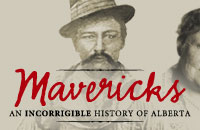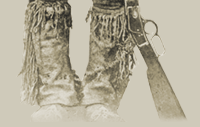 |

[ Project Plans | Essential
Questions | Knowledge Hunt | Glossary | Links ]
Show Us Your "True Grit"
Using Problem Solving Processes to Understand the Day-to-Day Challenges
Early Ranchers Faced
Introduction
Students need to understand and appreciate how the factors that
contribute to our quality of life have changed over the past 100
years. Through examining the problems and challenges early Alberta
ranchers faced, students will gain a respect for a very difficult
way of life. What was day-to-day life like for the early Alberta
ranchers? How did Alberta's physical geography and natural
environment both sustain them and challenge them? How did they live
without all of our modern conveniences?
Project Explanation
In this project, students will develop an appreciation of the factors
contributing to the quality of life in Alberta through investigating
the quality of life for the early Alberta ranchers about 100 years
ago. Problems that would be very normal for the ranching Mavericks
would be much more difficult to solve back then. After doing some
general research into the early Alberta ranching lifestyle, students
will have to come up with a plan in order to deal with an ordinary
problem faced by someone who lived in those times and compare that
plan to how we would solve a similar problem now. A short presentation
and discussion with the rest of the class will allow them to gain
a deeper understanding of how people lived at that time in Alberta.
Alberta Social Studies Curriculum Unit Connections
Grade Four - Alberta: The Land, Histories and Stories
4.1 Alberta: A Sense of the Land
4.2 The Stories, Histories and People of Alberta
4.3 Alberta: Celebrations and Challenges
Grade Five - Canada: The Land, Histories and Stories
5.1 Physical Geography of Canada
5.2 Histories and Stories of Ways of Life in Canada
Materials and Resources Needed
Procedures
Students will examine day-to-day problems that were faced by ranching
families on the open range. They will be given a general problem
that demonstrates the difficulties in the lifestyle these people
faced as compared to our modern lifestyle. The students will then
have to identify the problem(s), figure out the possible causes,
brainstorm possible solutions, evaluate the possible solutions (pros
and cons), debate the potential solutions in their groups, and decide
on a course of action. Finally, they would examine and compare how
we would solve the problem now.
Introduce the students to the idea that they will be becoming ranchers
back in the 1880's and will have to face some of the difficulties
that a ranching family would have had to deal with. Review the problem
solving process they will follow and share the manner in which the
information will be put together, using writing journals, notepaper,
or the graphic organizer.
Students may work individually or in small groups. They will need
to choose one of the following problems, either randomly or by personal
interest. You may choose to allow more than one group to work on
a specific problem and then compare and debate their solutions.
- You are a "Greenhorn" (a new person who does not
know the ropes) and have signed up to come on a cattle drive to
Alberta from the United States. How will you learn all the cowboy
skills you will need, like taking care of cattle, riding your
horse, and roping?
- You are bringing your family out to Alberta to start up your
very own ranch. You are in the middle of the open prairie, when
one of your wagon wheels breaks a number of spokes. What will
you have to do to get on your way again?
- Your family has just arrived in Alberta in late August on the
open prairies. You want to start your own ranch and raise cattle.
What will you do for shelter as winter is coming soon? What materials
will you use to build it? How will it be designed?
- Your family has just arrived in Alberta in late August on the
open prairies. You want to start your own ranch and raise cattle.
What will you for food in order to get through the winter?
- Your family has just arrived in Alberta in late August on the
open prairies. You want to start your own ranch and raise cattle.
What will you do to make sure your family has clean drinking water?
What would you do in the winter when everything freezes over?
- As there is no such thing as refrigerators, food tends to go
rotten very quickly. How will you minimize how much food goes
to waste?
- The trip to Alberta was long and arduous. My leather boots have
a growing hole on the bottom of the sole and water leaks in now.
What will I do to either fix them or get new ones?
- During branding season, one of the calves gets a hold of my
shirt and puts a large rip in it. Do I need a new one or can I
fix it? Where will I get the money and the materials to fix it?
- Working with cattle is a dirty business! On a cattle drive while
riding your horse on a wet day, mud is kicked up and gets all
your favourite clothes extremely soiled and muddy. The cowboys
have just stopped for the night and you are very tired. What will
you do about your clothes?
- During the winter at the ranch, your son gets very sick and
there is no doctor within an hours ride. What will you do to help
him get back to health?
- Your horse suddenly rears (rises on its hind legs) when you
were not expecting it. You fall off and break your leg and there
is no doctor within an hours ride. What will you do to get back
to health? Who will do the chores and take care of the cattle?
- The weather during the summer becomes very hot and turns into
a drought (a long period of very low rainfall). It has not rained
in your area for three months and the creeks, rivers, and sloughs
(a type of wetland, it is a depression or hollow on a prairie
that is usually filled with water) are drying up. Grasses to feed
your cattle are not growing properly. How will you take care of
your cattle and your family during the drought?
- During the winter, a major snowstorm hits, covering all the
grasses that the cattle eat. There is also no shelter for your
herd and the weaker ones are close to dying. How will you help
your herd to survive?
- Your favourite horse does not see a gopher hole, steps in it
and breaks one of his legs. There is no veterinarian to help take
care of it. How will you help your horse?
- In the middle of the night, as you are fast asleep, the cattle
begin to wail. The family dog starts barking and will not stop.
As you lay in your warn, snuggly bed, you know that something
needs to be done. What might be wrong and how will you take care
of it?
- In the days of the open range in Alberta, there were no fences
at all between Calgary and Fort Macleod. In the spring and fall,
the cowboys would go on a roundup to collect all their cattle,
which were identified by their brands. This could take a few weeks
of searching for and herding cattle. During this time, how would
you meet your basic needs (such as food supply, shelter to sleep
in, extra clothing, and taking care of your horses)?
- The open range in Alberta was a very sparse place to live. The
ranchers in your area have children growing up, but there is no
school or schoolteachers for them to go to. How would the ranchers
have dealt with this problem?
- You have a young family with six small children. The family
needs more space, as the one room house you are in is getting
very crowded. How will you solve this? What materials will you
use? When would be the best time to work out the shortage of space?
- During the winter in Alberta, it gets dark very early and the
sun comes up late in the morning. At night when it is dark, what
will your family do for entertainment in your small, one room
house?
The students will begin by identifying the problem or problems
that are the causes of the difficulty. What is causing the problem?
What are other problems that may come up because of it? What are
all the things we will have to take care of in order to solve the
problem?
The groups will then work together to brainstorm possible solutions
to the problem they have been given. Review the brainstorming process
before proceeding.
- Group members may not criticize or evaluate ideas during the
session. Criticism may tend to stifle creative thinking.
- Group members should be enthusiastic and let everyone contribute
and develop ideas.
- Have fun brainstorming. Come up with as many ideas as possible,
from wildly crazy ideas to very practical ones.
- Group members should try to develop other people's ideas, or
use those ideas to create brand new ones.
- Appoint one group member to jot down ideas the others come up
with.
At this point, students may begin to research and find information
on how early Alberta ranchers would have solved these problems using
the resources listed above or others that are accessible.
As a group, they would then evaluate the possible solutions (pros
and cons) that they have come up with. They should narrow them down
to the best three to five solutions, and then begin to discuss and
debate which one seems the best solution and the reasons why. The
group should decide on a fair way to make a final decision and come
to a consensus as to what their course of action would be.
Finally, they would examine and compare how we would solve a similar
problem now, using the technology and resources that are available
to us. Where the solutions very different? Would one solution require
a lot more work than the other? Which time would be easier to live
in? Which time would you want to live in?
Assessment and Evaluation
- Students and their teacher should develop their own rubric by
identifying evaluation criteria for the project that will match
their own learner outcomes. This allows students to understand
the expectations for their work and to have input into the ongoing
evaluation process.
- Individually or in small groups, students might evaluate the
work of two or three other students in order to gain insight into
how their peers approached the project.
- Students should use their journal to demonstrate their journey
through the problem solving process. This will allow the teacher
to evaluate whether they looked at all content and possibilities,
their brainstorming, the pros and cons they examined for their
solution, and why they settled on the solution they did.
Ideas for Enriching this Project
- Student groups could work on the same problems at the same time
and debate the validity of their chosen solutions.
- Students could contact a ranching expert to meet with the class
and discuss how these problems would be solved on a modern ranch.
- Students could conduct an "Object Study" using the
Ranching Artifacts and Documents in the Mavericks: An Incorrigible
History of Alberta site. How would early ranchers have used
this object to help solve the group's problem?
 |



![]()
